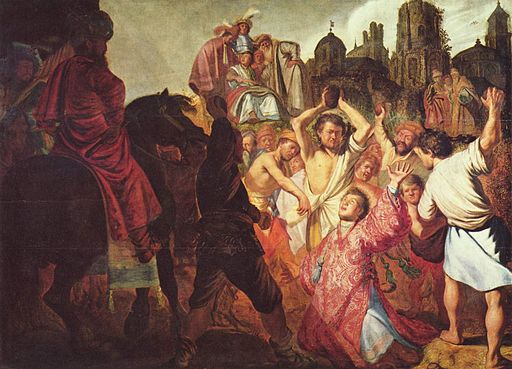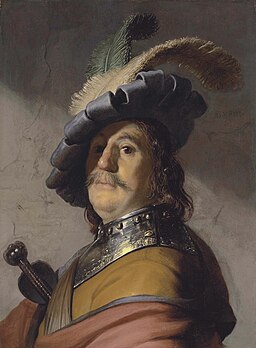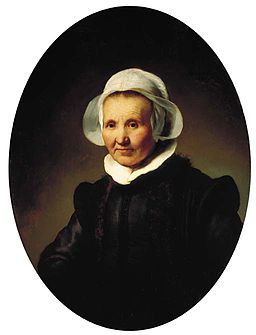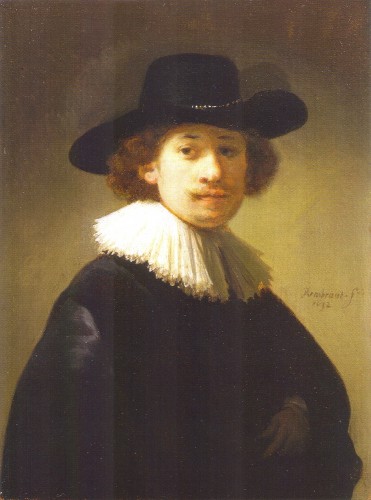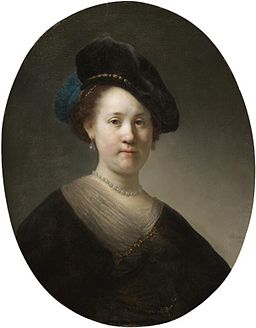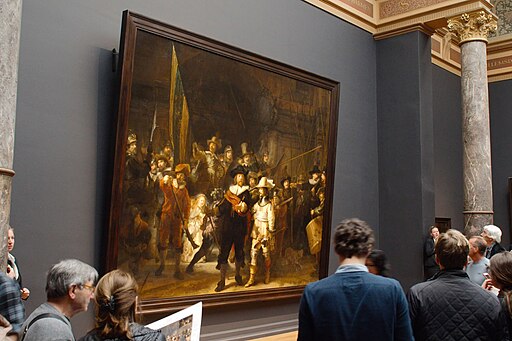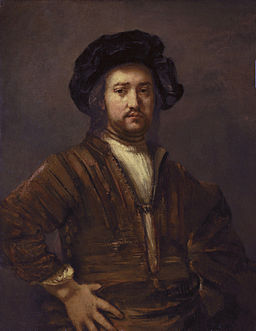REMBRANDT (1606-1669)
breakthrough
1625 Stoning of St. Stephen
Musée de Lyon
Working in his hometown Leiden in a productive rivalry with the child prodigy Jan Lievens, the young and ambitious Rembrandt van Rijn manages to revolutionize the art of painting for its effects of light on the faces, night and day, bold compositions and unconventional themes. He makes his hand to tronies, self portraits and the biblicals conducive to bring him patrons and fame.
In 1625, an early painting is a stoning of St. Stephen. It is a chiaroscuro separated by a diagonal, seeking by this bold composition to highlight the epic nature of the scene. The image is shared by Wikimedia.
In 1625, an early painting is a stoning of St. Stephen. It is a chiaroscuro separated by a diagonal, seeking by this bold composition to highlight the epic nature of the scene. The image is shared by Wikimedia.
1626-1627 Bust portrait of a soldier
2012 SOLD for £ 8.4M by Christie's
In 1626/1627, Rembrandt was operating a studio in Leiden, his hometown, in cooperation with Jan Lievens. Both artists, aged 20, had been apprentices with Pieter Lastman in Amsterdam, and were already known for their immense talent.
Rembrandt wants to show his skills as a portraitist and specializes in tronies, these anonymous figures of characters showing varied human types. To win clients, he endeavours to show that he is mastering the technique of painting, the composition, and of course these contrasts of light and shadow made popular by Caravaggio and his followers.
On July 3, 2012, Christie's sold for £ 8.4M the bust portrait of a soldier, a small panel 40 x 29 cm. Please watch the video shared by the auction house. The image is shared by Wikimedia.
The chiaroscuro is particularly marked in this work, where half of the face is in the shadow of the wide hat. The realism of this heavy face is pretty neat. Whether you are beautiful or ugly, your best portrait will be done by the specialist, Harmensz Rembrandt van Rijn. The character is of course not identifiable, nor the origin of his uniform.
Rembrandt wants to show his skills as a portraitist and specializes in tronies, these anonymous figures of characters showing varied human types. To win clients, he endeavours to show that he is mastering the technique of painting, the composition, and of course these contrasts of light and shadow made popular by Caravaggio and his followers.
On July 3, 2012, Christie's sold for £ 8.4M the bust portrait of a soldier, a small panel 40 x 29 cm. Please watch the video shared by the auction house. The image is shared by Wikimedia.
The chiaroscuro is particularly marked in this work, where half of the face is in the shadow of the wide hat. The realism of this heavy face is pretty neat. Whether you are beautiful or ugly, your best portrait will be done by the specialist, Harmensz Rembrandt van Rijn. The character is of course not identifiable, nor the origin of his uniform.
1628 The Adoration of the Kings
2023 SOLD for £ 11M by Sotheby's
Staging by night an Adoration of the Kings with the Star of Bethlehem as a secondary light is probably unprecedented. A small oil on oak panel 24.5 x 18.5 cm upright painted in grisaille and sepia with ochre ca 1628 is certainly a sketch for an etching that was never made, or made in another theme such as the 1630 Presentation to the Temple.
At that time the artist also used the technique of oil on copper for small size such as a Denial of St. Peter also processed as an Oriental multi-figure nocturnal lit from the left.
The Adoration had been considered as painted by Rembrandt until an auction at Christie's in 1985. Once again offered as from the circle of Rembrandt by Christie's while providing the visibility to the former full attribution, it was sold for € 860K from a lower estimate of € 10K on October 6, 2021, lot 7.
Re-attributed to Rembrandt by Sotheby's through infrared imaging revealing the scratches of the pictorial revisions over black framing lines, it iwas sold for £ 11M on December 6, 2023, lot 11. Please watch the video shared by the auction house.
At that time the artist also used the technique of oil on copper for small size such as a Denial of St. Peter also processed as an Oriental multi-figure nocturnal lit from the left.
The Adoration had been considered as painted by Rembrandt until an auction at Christie's in 1985. Once again offered as from the circle of Rembrandt by Christie's while providing the visibility to the former full attribution, it was sold for € 860K from a lower estimate of € 10K on October 6, 2021, lot 7.
Re-attributed to Rembrandt by Sotheby's through infrared imaging revealing the scratches of the pictorial revisions over black framing lines, it iwas sold for £ 11M on December 6, 2023, lot 11. Please watch the video shared by the auction house.
for reference
1628 Denial of St. Peter
Artizon Museum, Tokyo
The image is shared by Wikimedia.
masterpiece
1632 The Anatomy Lesson
Mauritshuis
The image is shared by Wikimedia.
1632 Portrait of an Old Woman by Rembrandt
2000 SOLD for £ 20M including premium by Christie's
narrated in 2020
In 1631 Rembrandt Harmenszoon van Rijn begins to be known. The majority of his customers are no longer in Leiden but in Amsterdam. The art dealer Hendrick Uylenburgh accommodates him and provides him with a studio in the richest city in the world.
Thus freed from material constraints, Rembrandt can therefore devote himself to his art. 1632 is both a prolific and an experimental year. He begins to sell self-portraits, probably to better introduce himself to the wealthy clients of Uylenburgh.
The main talent of Rembrandt is in the expressive realism of the portraits. The light is centered on the face and fades at the periphery of the image. The young artist experiments with the oval format which elegantly reduces the dark corners. It seems that the oval panels preceded the false frames painted on rectangular panels.
On December 13, 2000, Christie's sold the portrait of an old woman for £ 20M including premium from a lower estimate of £ 4M, lot 52. The image is shared by Wikimedia. The bevelling of this 74 x 56 cm panel attests that the picture was oval from the start.
The portrait is signed van Ryn with the monogram RHL which marks the initials of his first name and his previous installation in Leiden. The artist has not yet found the best way to identify himself : in the same year, he sometimes signs with the simplified version Rembrant of his first name.
The painting is dated 1632. The woman is not identified, which attests that the portrait was painted for the use of her family. Her age is indicated : 62 years old.
In this half-length portrait, Rembrandt uses the padding of the shoulders to show that the woman is frail and petite. The eyes and the smile are a little tired. The cap is an essential accessory for a bourgeois woman of that time.
After investigation about the entourage of the artist, this person can only be Aeltje Sylvius née Uylenburgh, a cousin of the dealer Hendrick. She and her husband also appear in other paintings. Rembrandt married her niece Saskia Uylenburgh in 1634.
Thus freed from material constraints, Rembrandt can therefore devote himself to his art. 1632 is both a prolific and an experimental year. He begins to sell self-portraits, probably to better introduce himself to the wealthy clients of Uylenburgh.
The main talent of Rembrandt is in the expressive realism of the portraits. The light is centered on the face and fades at the periphery of the image. The young artist experiments with the oval format which elegantly reduces the dark corners. It seems that the oval panels preceded the false frames painted on rectangular panels.
On December 13, 2000, Christie's sold the portrait of an old woman for £ 20M including premium from a lower estimate of £ 4M, lot 52. The image is shared by Wikimedia. The bevelling of this 74 x 56 cm panel attests that the picture was oval from the start.
The portrait is signed van Ryn with the monogram RHL which marks the initials of his first name and his previous installation in Leiden. The artist has not yet found the best way to identify himself : in the same year, he sometimes signs with the simplified version Rembrant of his first name.
The painting is dated 1632. The woman is not identified, which attests that the portrait was painted for the use of her family. Her age is indicated : 62 years old.
In this half-length portrait, Rembrandt uses the padding of the shoulders to show that the woman is frail and petite. The eyes and the smile are a little tired. The cap is an essential accessory for a bourgeois woman of that time.
After investigation about the entourage of the artist, this person can only be Aeltje Sylvius née Uylenburgh, a cousin of the dealer Hendrick. She and her husband also appear in other paintings. Rembrandt married her niece Saskia Uylenburgh in 1634.
1632 A Business of Self Portraits
2020 SOLD for £ 14.5M including premium
Rembrandt Harmenszoon van Rijn had a gift for facial analysis and wanted to specialize in portrait painting. The realistic portrait of a soldier with the shadow from the hat on the right side of the face, painted in Leiden circa 1626, was probably a demonstrative model. It was sold for £ 8.4M including premium by Christie's on July 3, 2012.
Rembrandt was early interested in self-portrait, perhaps under the influence of his crossed portraits with his workshop colleague Jan Lievens. He used this theme from 1631 in several etchings.
Glory rewards talent. Rembrandt moved to Amsterdam at the end of 1631 while also working on commission in The Hague. In 1632 he painted numerous portraits as well as his first masterpiece of group scenes, the Anatomy Lesson of Dr Tulp.
Rembrandt then took an unprecedented initiative : rather than offering tronies, he painted self-portraits for sale. The painting is executed quickly with a wet in wet signature. If the piece is not sold, the support is reused. Self-portraits of the artist are certainly still hidden under a repaint made by his workshop.
On July 28 in London, Sotheby's sells one of these self-portraits, lot 12 estimated £ 12M. This oil on panel 22 x 16 cm is dated 1632, which is consistent with the very ephemeral variant 'Rembrant' of his signature. Please watch the video shared by the auction house. The image is shared by Wikimedia.
The demonstration of authenticity is based on autograph pentiments, and by the use of a board from the same oak as a portrait painted in the same year by Rembrandt. It is one of only two self-portraits on which Rembrandt is dressed as a respectable burger, with a very large ruff and a felt hat. The small format suggests that it is a portable piece which can be used as a sort of business card.
Rembrandt was early interested in self-portrait, perhaps under the influence of his crossed portraits with his workshop colleague Jan Lievens. He used this theme from 1631 in several etchings.
Glory rewards talent. Rembrandt moved to Amsterdam at the end of 1631 while also working on commission in The Hague. In 1632 he painted numerous portraits as well as his first masterpiece of group scenes, the Anatomy Lesson of Dr Tulp.
Rembrandt then took an unprecedented initiative : rather than offering tronies, he painted self-portraits for sale. The painting is executed quickly with a wet in wet signature. If the piece is not sold, the support is reused. Self-portraits of the artist are certainly still hidden under a repaint made by his workshop.
On July 28 in London, Sotheby's sells one of these self-portraits, lot 12 estimated £ 12M. This oil on panel 22 x 16 cm is dated 1632, which is consistent with the very ephemeral variant 'Rembrant' of his signature. Please watch the video shared by the auction house. The image is shared by Wikimedia.
The demonstration of authenticity is based on autograph pentiments, and by the use of a board from the same oak as a portrait painted in the same year by Rembrandt. It is one of only two self-portraits on which Rembrandt is dressed as a respectable burger, with a very large ruff and a felt hat. The small format suggests that it is a portable piece which can be used as a sort of business card.
1632 Bust of a Girl by Rembrandt
1986 SOLD for £ 7.3M including premium, worth US$ 10.3M at that time, by Sotheby's
narrated in 2021
Rembrandt is the best portrait painter of his time. He knows it and wants it to be known. In his workshop in Leiden, he paints imaginary tronies of men of all ages. After arriving in Amsterdam in 1632 at the age of 26, he continues this practice while adding portraits of his family and of his future in-laws.
The superiority of his art consists in the physiognomy, the expressiveness, the subtle effect of light on the skin. In Amsterdam, he ads costume tronies to his repertoire, to demonstrate his skill in showing exquisite silks and embroidery as well as jewelry.
An oval tronie of a blonde girl dated 1632 was sold by Sotheby's on December 10, 1986 for £ 7.3M including premium, worth at that time US $ 10.3M. The image is shared by Wikimedia. It was painted in oil on a 59 x 44 cm mahogany panel, which is consistent with Rembrandt's practice at that time of favoring wood over canvas for small formats.
The face is fresh and youthful, with chubby pink cheeks. She has long been identified as the artist's sister but this attribution has been refuted. The collar and opening of the coat is amply edged in gold over elegant embroidery and she wears earrings.
The superiority of his art consists in the physiognomy, the expressiveness, the subtle effect of light on the skin. In Amsterdam, he ads costume tronies to his repertoire, to demonstrate his skill in showing exquisite silks and embroidery as well as jewelry.
An oval tronie of a blonde girl dated 1632 was sold by Sotheby's on December 10, 1986 for £ 7.3M including premium, worth at that time US $ 10.3M. The image is shared by Wikimedia. It was painted in oil on a 59 x 44 cm mahogany panel, which is consistent with Rembrandt's practice at that time of favoring wood over canvas for small formats.
The face is fresh and youthful, with chubby pink cheeks. She has long been identified as the artist's sister but this attribution has been refuted. The collar and opening of the coat is amply edged in gold over elegant embroidery and she wears earrings.
1632 Young Woman in a Beret by Rembrandt
2007 SOLD for $ 9M including premium by Sotheby's
narrated in 2021
Recently installed in Amsterdam, Rembrandt develops a new format in 1632 : the bust portrait on an oval panel. He thus paints self-portraits, portraits of his relatives and tronies.
The old woman, although not identified, is one of his relatives : he took care to inscribe her age. This 74 x 56 cm panel was sold for £ 20M including premium by Christie's on December 15, 2000.
The young blonde woman, 59 x 44 cm panel sold for £ 7.3M including premium by Sotheby's on December 10, 1986, has long been considered the sister of artist, Lysbeth. The authentication of a portrait of a brunette with the same youthful face helped refute this hypothesis.
When they were able to inspect this latter portrait in 1972 at the home of its owner, the experts from the Rembrandt Research Project (RRP) described it as a work painted outside the artist's circle. Two elements did not match the master's practice. The oval support, 69 x 54 cm, was not a panel but a canvas stretched on wood. The exotic garment with gold embroidery and the black beret form a disparate ensemble that does not correspond to the fashion of that time.
The RRP wanted to compare this work in 1995 with two other versions. X-ray analysis showed that the primary layers of paint matched Rembrandt's 1632 practice and that the piece of canvas was already known from another authentic painting.
Freed from overpaints and from an old varnish, the oil on canvas has regained the superior qualities of a Rembrandt, with the accentuation of the volume by the angle of the light on the nose and the dimples. It was also identified that the oval shape had not been cut at the time of the execution of the work. The best guess is that an 18th century collector changed the format so that this painting would make a pendant with an oval self-portrait of Rembrandt that he also owned.
The portrait of the young woman in the beret was sold for $ 9M including premium by Sotheby's on January 25, 2007 from a lower estimate of $ 3M, lot 6. The image is shared by Wikimedia.
The old woman, although not identified, is one of his relatives : he took care to inscribe her age. This 74 x 56 cm panel was sold for £ 20M including premium by Christie's on December 15, 2000.
The young blonde woman, 59 x 44 cm panel sold for £ 7.3M including premium by Sotheby's on December 10, 1986, has long been considered the sister of artist, Lysbeth. The authentication of a portrait of a brunette with the same youthful face helped refute this hypothesis.
When they were able to inspect this latter portrait in 1972 at the home of its owner, the experts from the Rembrandt Research Project (RRP) described it as a work painted outside the artist's circle. Two elements did not match the master's practice. The oval support, 69 x 54 cm, was not a panel but a canvas stretched on wood. The exotic garment with gold embroidery and the black beret form a disparate ensemble that does not correspond to the fashion of that time.
The RRP wanted to compare this work in 1995 with two other versions. X-ray analysis showed that the primary layers of paint matched Rembrandt's 1632 practice and that the piece of canvas was already known from another authentic painting.
Freed from overpaints and from an old varnish, the oil on canvas has regained the superior qualities of a Rembrandt, with the accentuation of the volume by the angle of the light on the nose and the dimples. It was also identified that the oval shape had not been cut at the time of the execution of the work. The best guess is that an 18th century collector changed the format so that this painting would make a pendant with an oval self-portrait of Rembrandt that he also owned.
The portrait of the young woman in the beret was sold for $ 9M including premium by Sotheby's on January 25, 2007 from a lower estimate of $ 3M, lot 6. The image is shared by Wikimedia.
masterpiece
1634 the Soolmans-Coppit portraits
joined ownership of Louvre and Rijksmuseum
Over a decade ago, these two #Rembrandt portraits made headlines when the #Rothschild family offered to sell them to the Louvre. When their price was too high, a more interesting solution was found…
— Barnebys.co.uk (@Barnebysuk) March 21, 2024
1635 the van der Pluym Portraits
2023 SOLD for £ 11.2M by Christie's
Rembrandt moved from Leiden to Amsterdam in 1631. Supported by the art dealer Hendrick Uylenburgh to serve new customers, he was very prolific in commissioned portraits but also in tronies, in self portraits and in portraits of people in his inner circle. The oval portrait 74 x 56 cm dated 1632 of an unidentified woman painted at age 62 is a great example, sold for £ 20M by Christie's in 2000.
Rembrandt wants to extend his know how to history scenes and departs from Uylenburgh's studio in 1635. Nevertheless three pairs featuring couples of husband and wife are dated from that year.
One of these pairs, oil on oval panels 20.8 x 16.7 cm and 19.9 x 16.7 cm, was identified as a Rembrandt work until they were auctioned by Christie's in 1824. They went out of view of all Rembrandt experts for two centuries, treasured by the family of the purchaser until found by Christie's in a routine valuation.
This diminutive format attests that these bust length portraits were featuring a couple of the inner circle. They are identified from slightly later three quarter length portraits painted by some Rembrandt's followers as Jan Willemsz. van der Pluym, a wealthy plumber in Leiden, and his wife Jaapgen, both turning 70 in 1635, who were neighbors to Rembrandt's mother. A reference in the deceased estate of their daughter certainly refers to that pair.
Curiously the dendrochronology concludes that the panels came from trees of different periods, opening the assumption that one of them was painted in Amsterdam and the other one in Leiden.
This unseparated pair was sold for £ 11.2M from a lower estimate of £ 5M by Christie's on July 6, 2023, lot 11. Please watch the video shared by the auction house explaining the authenticity of this lot, demonstrated by experts from the Rijksmuseum over a 18 month research. Rembrandt was in his time the only Dutch artist able to paint wet on wet.
Rembrandt wants to extend his know how to history scenes and departs from Uylenburgh's studio in 1635. Nevertheless three pairs featuring couples of husband and wife are dated from that year.
One of these pairs, oil on oval panels 20.8 x 16.7 cm and 19.9 x 16.7 cm, was identified as a Rembrandt work until they were auctioned by Christie's in 1824. They went out of view of all Rembrandt experts for two centuries, treasured by the family of the purchaser until found by Christie's in a routine valuation.
This diminutive format attests that these bust length portraits were featuring a couple of the inner circle. They are identified from slightly later three quarter length portraits painted by some Rembrandt's followers as Jan Willemsz. van der Pluym, a wealthy plumber in Leiden, and his wife Jaapgen, both turning 70 in 1635, who were neighbors to Rembrandt's mother. A reference in the deceased estate of their daughter certainly refers to that pair.
Curiously the dendrochronology concludes that the panels came from trees of different periods, opening the assumption that one of them was painted in Amsterdam and the other one in Leiden.
This unseparated pair was sold for £ 11.2M from a lower estimate of £ 5M by Christie's on July 6, 2023, lot 11. Please watch the video shared by the auction house explaining the authenticity of this lot, demonstrated by experts from the Rijksmuseum over a 18 month research. Rembrandt was in his time the only Dutch artist able to paint wet on wet.
Two #Rembrandt portraits hidden from public view for 200 years: 'They were essentially lost pictures'. Read here: https://t.co/E5ZoJGvI4D pic.twitter.com/S0hMbcCm0Q
— Christie's (@ChristiesInc) July 5, 2023
masterpiece
1642 The Night Watch (De Nachtwacht)
Rijksmuseum
The image in the Rijksmuseum is shared by Wikimedia with attribution Rembrandt, CC BY-SA 2.0 <https://creativecommons.org/licenses/by-sa/2.0>, via Wikimedia Commons
1648 Humility of Christ
2018 SOLD for £ 9.5M including premium
The end of the 1640s is very difficult for Rembrandt. He is a widower and his life with his son's nanny creates a scandal. Orders cease and his financial situation is very bad. He is nevertheless one of the best portrait painters of his time.
The scenes from the Gospels are part of his offer. In 1648 he paints The Pilgrims of Emmaus, oil on wood 68 x 65 cm preserved in the Musée du Louvre. Christ, who is of course the central character, responds to his traditional figuration, with waving hair covering his shoulders and with a short beard.
Rembrandt is more interested in the realism and psychology of faces than in mysticism. The young man who posed for the Emmaus scene is recognizable in a group of portraiture studies with various positions of the head that express the concentration of prayer and the humility, without a halo.
Two of these portraits were considered as autographs by the Rembrandt Research Project. The four or five other paintings in this group are copies of lost originals or imitations.
One of the two authentic portraits, oil on wood 25 x 21 cm, is kept at the Gemäldegalerie in Berlin. The other one, in same technique and dimensions, is estimated £ 6M for sale by Sotheby's in London on December 5, lot 18. Please watch the video prepared by the auction house. The image is shared by Wikimedia.
The scenes from the Gospels are part of his offer. In 1648 he paints The Pilgrims of Emmaus, oil on wood 68 x 65 cm preserved in the Musée du Louvre. Christ, who is of course the central character, responds to his traditional figuration, with waving hair covering his shoulders and with a short beard.
Rembrandt is more interested in the realism and psychology of faces than in mysticism. The young man who posed for the Emmaus scene is recognizable in a group of portraiture studies with various positions of the head that express the concentration of prayer and the humility, without a halo.
Two of these portraits were considered as autographs by the Rembrandt Research Project. The four or five other paintings in this group are copies of lost originals or imitations.
One of the two authentic portraits, oil on wood 25 x 21 cm, is kept at the Gemäldegalerie in Berlin. The other one, in same technique and dimensions, is estimated £ 6M for sale by Sotheby's in London on December 5, lot 18. Please watch the video prepared by the auction house. The image is shared by Wikimedia.
1658 Rembrandt and Experts
2009 SOLD 20.2 M£ including premium
This morning in London, Christie's has invited the press to unveil a painting by Rembrandt that will be sold on December 8. This is sensible: the market for ancient art has a reputation of being little affected by the financial crisis.
It is a half-length portrait of a man, painted in 1658. It had not been seen publicly since 1970 and has not participated in the major exhibition made by the Rijksmuseum in Amsterdam in 2006 to celebrate the 400 th anniversary of the birth of the artist. It is estimated £ 18 million.
Rembrandt is the best studied artist in the world. Under the name of Rembrandt Research Project, a multidisciplinary team has been working since 1968 to authenticate or refute all the works that could be attributed to the master. This team, which was renewed several times, includes art historians and scientists.
Among the scientific methods used, we first think of the X-ray, of course. Do not neglect the dendrochronology, which allows to date the felling of the oak trees whose panels were used by the master. Historians, meanwhile, compared the artworks together by considering a consistency of style in order to separate the works of the master from those of his employees.
This work sponsored by the University of Amsterdam is extremely important. Thanks to these pioneers the ancient art has become the most exciting area of artistic expertise.
ADDENDUM
Small precision now that the official press release from Christie's is available on the web: the artwork for sale is on canvas, 107 x 87 cm.
My comments on dendrochronology do not apply to this work.
POST SALE COMMENT
The release by Christie's on Twitter expresses the essential: Rembrandt sells for £ 20.2M : the world auction record for a Rembrandt and the 4th highest price for an old master painting at auction.
The quoted price includes the premium.
I would add that this Rembrandt was important but not to the point of being described as historic. It is therefore quite understandable that it has not exceeded its estimate.
The image is shared by Wikimedia.
It is a half-length portrait of a man, painted in 1658. It had not been seen publicly since 1970 and has not participated in the major exhibition made by the Rijksmuseum in Amsterdam in 2006 to celebrate the 400 th anniversary of the birth of the artist. It is estimated £ 18 million.
Rembrandt is the best studied artist in the world. Under the name of Rembrandt Research Project, a multidisciplinary team has been working since 1968 to authenticate or refute all the works that could be attributed to the master. This team, which was renewed several times, includes art historians and scientists.
Among the scientific methods used, we first think of the X-ray, of course. Do not neglect the dendrochronology, which allows to date the felling of the oak trees whose panels were used by the master. Historians, meanwhile, compared the artworks together by considering a consistency of style in order to separate the works of the master from those of his employees.
This work sponsored by the University of Amsterdam is extremely important. Thanks to these pioneers the ancient art has become the most exciting area of artistic expertise.
ADDENDUM
Small precision now that the official press release from Christie's is available on the web: the artwork for sale is on canvas, 107 x 87 cm.
My comments on dendrochronology do not apply to this work.
POST SALE COMMENT
The release by Christie's on Twitter expresses the essential: Rembrandt sells for £ 20.2M : the world auction record for a Rembrandt and the 4th highest price for an old master painting at auction.
The quoted price includes the premium.
I would add that this Rembrandt was important but not to the point of being described as historic. It is therefore quite understandable that it has not exceeded its estimate.
The image is shared by Wikimedia.
1661 Saint James the Greater
2007 SOLD for $ 26M by Sotheby's
The portraits inspired to Rembrandt by the New Testament are from figures of the artist's entourage, with a view to realism. In Sevilla, Murillo has a similar approach.
Around 1648 Rembrandt was in one of his frequent financially and socially difficult periods, and he would like his Supper at Emmaus, a modern painting on a biblical theme, to relaunch his career. The portraits of a young man as Christ are studies painted in parallel or for the preparation of this masterpiece. An oil on panel 25 x 21 cm was sold for £ 9.5M including premium by Sotheby's on December 5, 2018.
The artist is indeed satisfied with this personification of Christ. The same young man appears as a Christ in half length with folded arms, oil on canvas 110 x 90 cm generally dated between 1657 and 1661.
In 1661 Rembrandt paints a series of Apostles, looking again at what the like of some of Christ's companions could be. This set of oils on canvas is homogeneous by its format, around 92 x 75 cm, by its chromatic richness, and by the presence of a thin black border which has not always been preserved.
This corpus of six works including a self portrait as Saint Paul was not documented in period. They were painted in another difficult phase for the artist and may have been conceived as a new demonstrator of the ever increasing quality of his art.
Rembrandt's faith was complex. His father was from a Jewish family converted to the Reformed church and his mother was Catholic. His realism excludes an identification of the character's religious position by a halo. The half length portrait of an old pilgrim in neglected clothes enters through its pictorial characteristics in the series of the Apostles, and the differentiated history of the companions of Christ after the Passion makes it attribute to Saint James the Greater.
This portrait of a man with a face concentrated on his prayer, whose very large joined hands form the focal point of the image, is an allegory of a faith that transcends appearances, directly linked to the Gospels and without any reference to the Mendicant orders. .
This painting was sold for $ 26M by Sotheby's on January 25, 2007, lot 74. The image is shared by Wikimedia.
Around 1648 Rembrandt was in one of his frequent financially and socially difficult periods, and he would like his Supper at Emmaus, a modern painting on a biblical theme, to relaunch his career. The portraits of a young man as Christ are studies painted in parallel or for the preparation of this masterpiece. An oil on panel 25 x 21 cm was sold for £ 9.5M including premium by Sotheby's on December 5, 2018.
The artist is indeed satisfied with this personification of Christ. The same young man appears as a Christ in half length with folded arms, oil on canvas 110 x 90 cm generally dated between 1657 and 1661.
In 1661 Rembrandt paints a series of Apostles, looking again at what the like of some of Christ's companions could be. This set of oils on canvas is homogeneous by its format, around 92 x 75 cm, by its chromatic richness, and by the presence of a thin black border which has not always been preserved.
This corpus of six works including a self portrait as Saint Paul was not documented in period. They were painted in another difficult phase for the artist and may have been conceived as a new demonstrator of the ever increasing quality of his art.
Rembrandt's faith was complex. His father was from a Jewish family converted to the Reformed church and his mother was Catholic. His realism excludes an identification of the character's religious position by a halo. The half length portrait of an old pilgrim in neglected clothes enters through its pictorial characteristics in the series of the Apostles, and the differentiated history of the companions of Christ after the Passion makes it attribute to Saint James the Greater.
This portrait of a man with a face concentrated on his prayer, whose very large joined hands form the focal point of the image, is an allegory of a faith that transcends appearances, directly linked to the Gospels and without any reference to the Mendicant orders. .
This painting was sold for $ 26M by Sotheby's on January 25, 2007, lot 74. The image is shared by Wikimedia.
